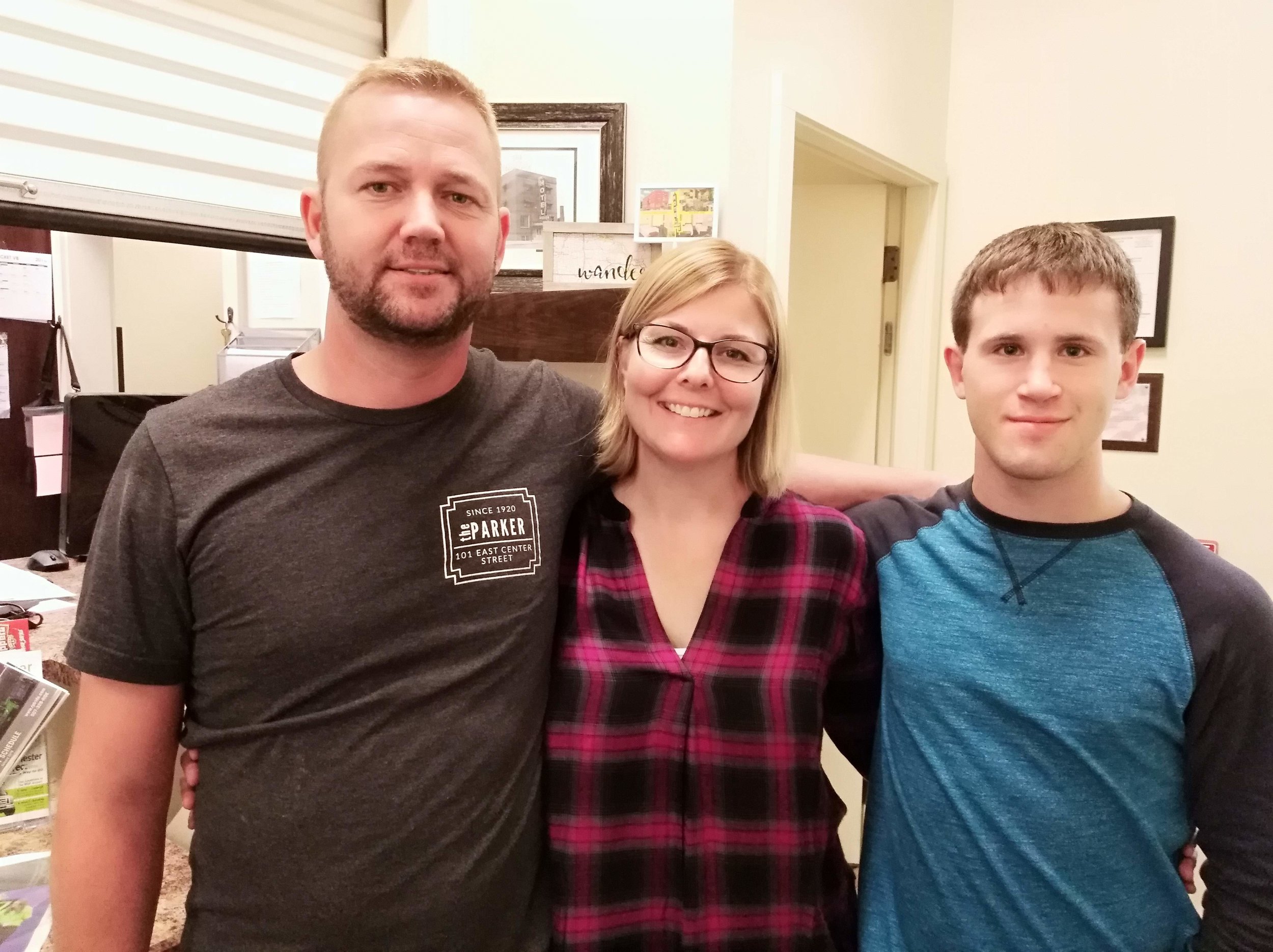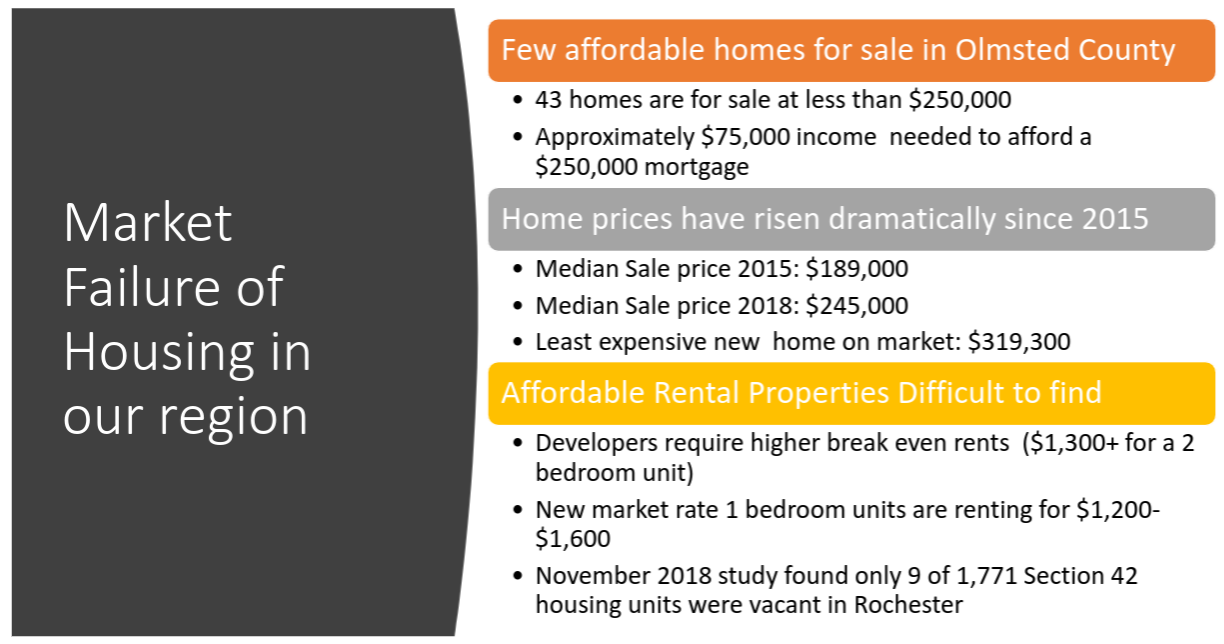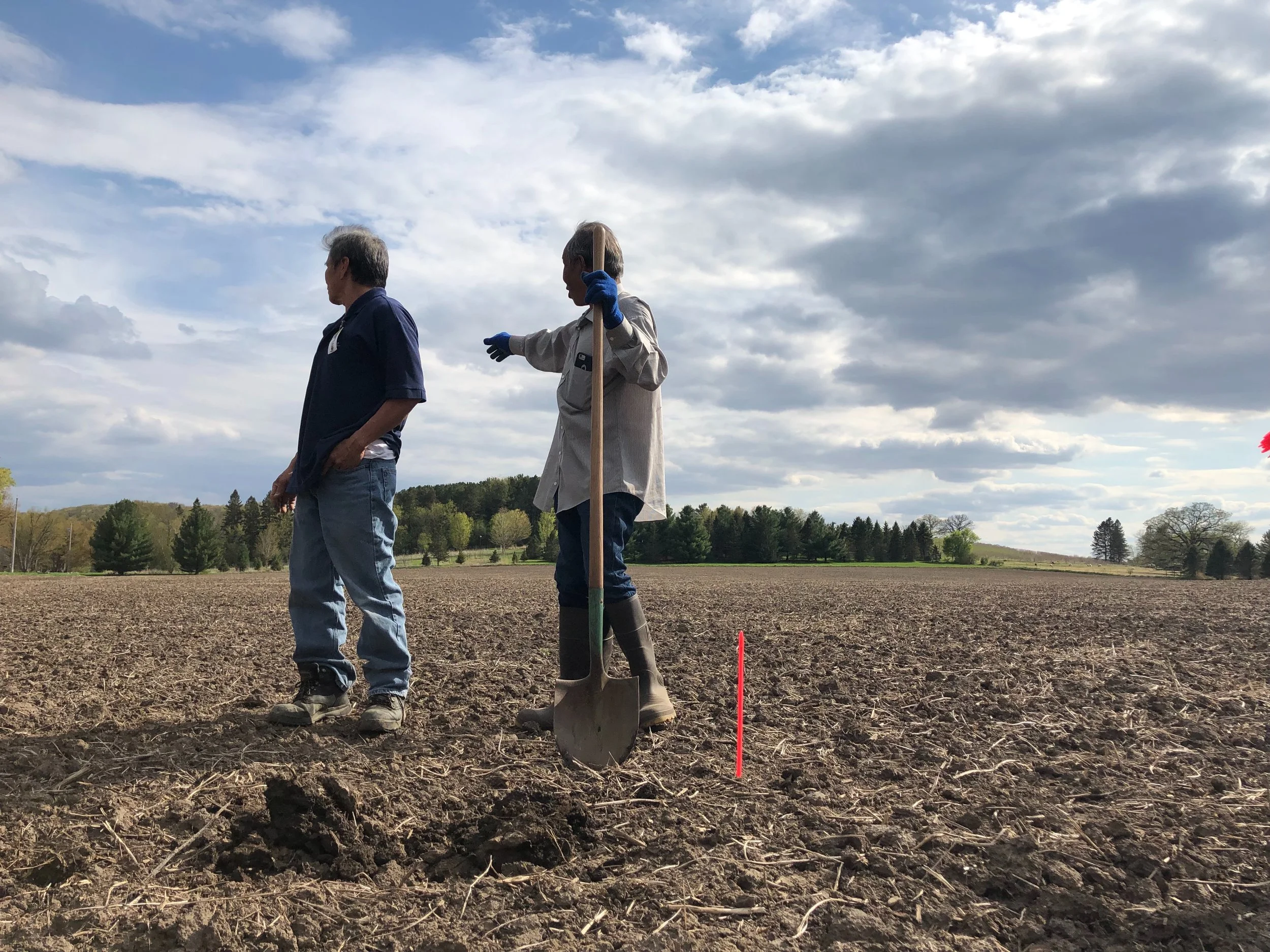Escalating costs drive home the need for more affordable housing in Rochester
“He is a magnet for anything, like, decaying and questionable and that had a bad reputation,” said Kari Ann Friederichs of her husband, Andy.
The two were sitting in one of 25 fully-furnished micro-units in The Beacon, 431 Third Avenue Southeast during the last week of May. It’s the third property the two have renovated and turned into affordable housing units as Resident Property Management.
They started in 2016 with The Parker, 101 East Center Street, where they created 62 kitchen-less units, called professional dorms or sleeping units. Next they created 19 units at 855 First Street Southwest.
The rooms all come fully furnished and renters are on a month-to-month lease at all of their properties. That flexibility isn’t just for downtowners. Their newest property, The Marion, 1600 Marion Road South, opened recently with 12 units at $750 per month.
They’d already had a handful of move-ins at the time of our interview, and the place looked on track to fill, much like their other properties.
“People are not afraid of a small space,” said Andy Friederichs.
In today’s housing market, they might not have a choice. What the Friederichs are doing with their properties is a piece of a complicated puzzle that city and business leaders say will require an entire toolbox of new policies and approaches to solve.
“There’s not one thing that’s going to make everything all better,” said Deputy City Administrator Terry Spaeth. “It’s going to be different combinations of things that are going to work for different projects.”
Steve Borchardt, housing director for the Coalition for Rochester Area Housing, agrees. The coalition has been working to foster collaboration between the city and other funding partners like the Rochester Area Foundation, Olmsted County HRA, Mayo Clinic (which donated $4 million to the endeavor), and developers. Typically, if a project is looking to fill a gap, they can work together through the coalition to look at the project and figure out what resources might work best.
Steve Borchardt / submitted
Looming over these efforts and others, though, is the problem of stock. Newer townhomes — which people typically move into as they age out of large single-family homes — can be costly, with units on the less-expensive end around $350,000, according to Borchardt. This means that the Baby Boomer generation is staying put, for now. And it makes sense — after years of house payments, why would a senior citizen take on a new mortgage when they could just sit tight in the home they have already paid off?
“I don’t have empirical data that quantifies this phenomenon but it is so common that every time I make a public presentation all the 60-plus gray heads in the audience are nodding in agreement,” said Borchardt.
With that kind of frozen inventory, the pace of units becoming available is stymied — and intensifying the need for new affordable housing units.
“Until that happens, you have people that can’t find places to live that are affordable,” said Rochester Mayor Kim Norton.
A broad, but workable, definition of affordable housing is housing that costs 30 percent of a person’s income, according to Dave Dunn, director of Olmsted County’s Housing and Redevelopment Authority. But achieving that threshold is becoming increasingly challenging for residents on the lower — and middle — rungs of the income ladder.
Borchardt outlined the scope of the problem to the Destination Medical Center Corporation's May board meeting (the discussion on affordable housing begins at 42:57). Much of the information he shared came from a report he compiled with realtor Jim Miner of Plaza Realty.
The report finds that median home prices have shot up since 2015, rising from $189,000 to $245,000 in 2018. Making matters worse, there are not even many homes available at that price-point. The report found only 43 homes in Olmsted county for sale for under $250,000.
Renters are in no better shape. Borchardt’s report says that new market rate 1-bedroom units are renting for $1,600 to $2,300 per month, and that $1,300 per month is seen as a barely-breaking-even price-point.
That lower end is growing bigger by the day, too.
As Spaeth, the assistant city administrator, said, “The wage levels, typically haven’t kept up with the cost of housing. Unless things change there, that gap is just going to continue to be there and probably widen even more as time goes by.”
The cost of doing business
The solution is not simply lowering rents. When people imagine high rents, they typically imagine a greedy landlord.
The truth is, that many — especially smaller outfits — are finding challenges trying to turn any kind of profit.
Resident Property Management carries debt and takes chances, and it costs them, sometimes. The Beacon took a year and a half to re-hab and re-open. That work included bringing the building up to current building codes, as well as securing the correct permits. For an operation like theirs, it’s a high-risk hoop-jumping act, and the most expensive of those hoops are the time-consuming ones, like waiting for government approval.
“It’s the wait,” said Andy. “It’s the loss of rent for a year and a half.”
Then, after the cost of developing or rehabbing an existing property come taxes, which, in Rochester, keep rising.
Since it opened, “our taxes at The Parker have almost tripled,” said Andy.
Left to right: Andy, Kari and Jared. Jared helps the couple manage their properties.
They are not alone. As reported by Randy Peterson of the Post-Bulletin, landlords across the city are grappling with rising property costs and taxes.
“There’s a reason all these places are charging what they’re charging. It’s because they have to,” said Andy.
This is where many feel government can step in to help.
“Part of [the solution] will involve re-thinking self-imposed barriers to affordability, such as building codes that increase safety and/or energy efficiency but add costs that price houses outside of affordability,” Borchardt told me via email. “Writ large, it begs the question of how much safety/security and/or energy efficiency is worth it if we are preventing families for achieving home ownership.”
Borchardt says developers need some incentive — usually profit, even if modest — to put their money toward a high-risk investment like a housing development or apartment building.
This is where a collaborative approach between government, which can alter fees and change building codes, and the private sector, capable of creating units, becomes crucial.
Making housing a 'societal priority’
Spaeth said that over the last few years he has seen the most affordable housing being developed for workforce units, which mean they target people in the 60 percent median income level.
Terry Spaeth / submitted
Those projects can secure housing tax credits or pursue housing revenue bonds to help finance the project, and what is referred to as the 4 percent housing income tax credit. It helps, he said.
“Although, in Olmsted County, the median income is fairly high, so even at 60 percent AMI, you know, the rents are still pretty substantial,” said Spaeth.
The current median household income in Rochester is about $68,574. Using data from the U.S. Census Bureau, USA Today ranked Rochester as the city with the 30th highest median income in the nation.
Those credits are governmental solutions that have existed for decades. The city, said Spaeth, acts as a sub-allocator of those credits, and Rochester-submitted projects tend to do well — each year one or more is approved.
In 2019, The Jeremiah Program secured housing tax credits, as did Harvest View, a project by Weis Construction.
According to Spaeth, the apartment tax class rate in Minnesota for a market rate apartment is 1.25 percent. For affordable housing units that meet statutory requirements for tax credits, that rate can go as low as 0.75 percent. Smaller developers might not know about these kinds of machinations, however. That’s where the Coalition for Rochester Area Housing comes in — by positioning itself as a kind of go-between for developers, governmental actors, and other concerned parties.
Connectivity between those parties will be needed to see more innovative ideas — like development above parking ramps, governmental assurance to landlords that rent will be paid, pocket neighborhoods, mobile homes, and development near transportation hubs — become reality.
“We have to make this a societal priority in all aspects,” said Borchardt. “It will not happen quickly and I can’t tell you what it will look like but I am confident it will happen.”
No magic bullet
As solutions percolate into existence, one the keys is to keep the affordable housing that does exist affordable.
The work of rehabbing older buildings into more dense living spaces, especially near the city core, falls right in line with what Spaeth thinks needs to happen. According to him, the city’s most affordable housing lies in older core neighborhoods.
“The question is — kinda becomes, how do you keep it affordable?” asks Spaeth. He is not alone in his concern.
“One of the frustrations that I have is that there are homes and they’re being bought up and rented, jacking the prices up,” remarked Mayor Norton. “People are using them as an investment. I don’t fault people for that, but I also hope that they understand that they’re taking an affordable house off the market for someone that maybe could benefit from that.”
Slide from the DMCC presentation on affordable housing
There are a limited number of tools the city has at its disposal now. TIF can help fill funding gaps, and the city can also work to reduce or waive fees.
However, “There’s not a lot of money in those pots to work with, so you can only put so big of a dent in the problem,” said Spaeth. He believes more federal and state sources are needed.
That is not to say the city is not trying. Almost a year ago, we reported on a policy of dedicating 5 percent of all redevelopment-type TIF increments to affordable housing.
The increments captured from that policy, however, will not be seen until around 2021. Most of the projects that policy has been applied to are not yet complete. He says they must still decide where those additional increments would go. One thought floating around is to use them to reduce or buy down development related fees, like building fees or sewer and water availability charge fees.
In the meantime, lone wolf innovators like the Friederichs will keep their fingers in the dam.
“The Parker’s wait-list is essentially filling whenever a unit becomes available,” said Kari.
Bryan Lund covers politics and culture for the Med City Beat.
In-depth coverage on Med City Beat is made possible thanks to the support of our members. To learn more about becoming a member, visit medcitybeat.com/membership.












